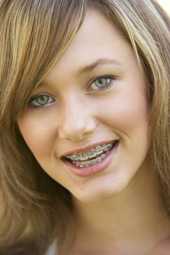Joseph H. Lohner, DDS, MS, PA
Request a Free Consultation Joseph H. Lohner, DDS, MS, PA Skyland Smiles651 County Road 517
973-764-2266 Sparta, NJ Office
21 Lafayette Road
973-729-9923

Life with Braces
Life with Braces | Patient Care Videos | Types of Braces | Braces Diagram | Retainers | Brace Painter | Types of Appliances | Emergency Care
Eating with Braces
What can you eat? Let's talk about what you shouldn't eat! If you've been wanting to drop a few pounds, the first week wearing braces is just your chance! For the first day or so, stick to soft foods. Avoid tough meats, hard breads, and raw vegetables. Before long, you'll be able to bite a cucumber again. But, you'll need to protect your orthodontic appliances when you eat for as long as you're wearing braces.



Foods to Avoid
- Chewy foods: bagels, hard rolls, licorice
- Crunchy foods: popcorn, ice, chips
- Sticky foods: caramels, gum
- Hard foods: nuts, candy
- Foods you have to bite into: corn on the cob, apples, carrots
- Chewing on hard things (for example, pens, pencils or fingernails) can damage the braces. Damaged braces will cause treatment to take longer. General Soreness
When you get your braces on, you may feel general soreness in your mouth and your teeth may be tender to biting pressures for one to five days. We recommend cold, soft foods (ice cream, yogurt, jello, etc.) and Tylenol or Advil if you need it (if you are not allergic to these medications). The lips, cheeks and tongue may also become irritated for one to two weeks as they toughen and become accustomed to the surface of the braces. You can put wax on the braces to lessen this. We'll show you how!
Other Links
Loosening of Teeth
This is to be expected throughout treatment. Don't worry! It's normal. Teeth must loosen first so they can be moved. The teeth will again become rigidly fixed in their new - corrected - positions.
Loose Wire or Band
Don't be alarmed if a wire or band comes loose. This happens occasionally. If wire protrudes and is irritating, use a blunt instrument (back of a spoon or the eraser end of a pencil) and carefully, gently push the irritating wire under the archwire. Simply get it out of the way. If irritation to the lips or mouth continues, place wax or wet cotton on the wire to reduce the annoyance. Call our office as soon as possible for an appointment to check and repair the appliances. If any piece comes off, save it and bring it with you to the office.

Care of Appliances
To successfully complete the treatment plan, the patient must work together with the orthodontist. The teeth and jaws can only move toward their corrected positions if the patient consistently wears the rubber bands, headgear or other appliances as prescribed. Damaged appliances lengthen the treatment time.
Brushing
It's more important than ever to brush and floss regularly when you have braces, so the teeth and gums are healthy after orthodontic treatment. Patients who do not keep their teeth clean may require more frequent visits to the dentist for a professional cleaning. Adults who have a history of gum disease should also see a periodontist during orthodontic treatment.
Athletics
If you play sports, it's important that you consult us for special precautions. A protective mouthguard is advised for playing contact sports. In case of any accident involving the face, check your mouth and the appliances immediately. If teeth are loosened or the appliances damaged, phone at once for an appointment. In the meantime, treat your discomfort as you would treat any general soreness.
Brushing with Braces
When you have braces, it's very important to brush and floss after every meal in order to keep your teeth and gums healthy throughout your orthodontic treatment. If you need help choosing the right toothbrush, toothpaste, and dental floss, please ask us and we can help you choose the right products for your teeth and your appliance.
Brush your teeth for two minutes after every meal with a soft-bristled, small-headed toothbrush and fluoride toothpaste. As an alternative, you can use a powered toothbrush to increase your brushing effectiveness. Brush the outside and inside surfaces of your teeth using small, gentle, circular motions while positioning the head of the toothbrush at a 45-degree angle to the gum line. Brush your teeth’s chewing surfaces and the inside surface of your front teeth using short, gentle, back-and-forth motions. Pay close attention to the areas around your brackets or other appliances.

Flossing with Braces
Flossing after every meal will help keep your teeth and braces clean, which will also help keep your treatment time on track. To floss with braces, use a floss threader or special orthodontic floss to thread the floss behind each wire. Wrap the ends of the floss around your pointer fingers of both hands, leaving a few inches of taught floss between them. Gently slide the floss between each set of teeth using a back and forth motion. Floss the sides of each tooth beneath the gum line to remove plaque and food particles. Repeat this process until you’ve flossed all of your teeth. If you find that your floss is not removing all of the food particles between your teeth and around your braces, ask us about a water flosser!

